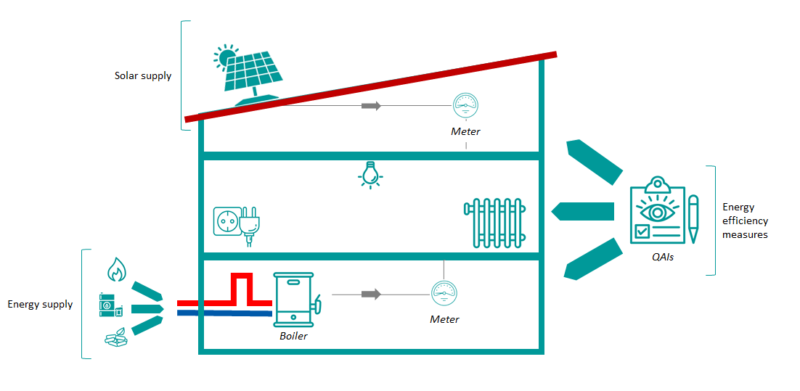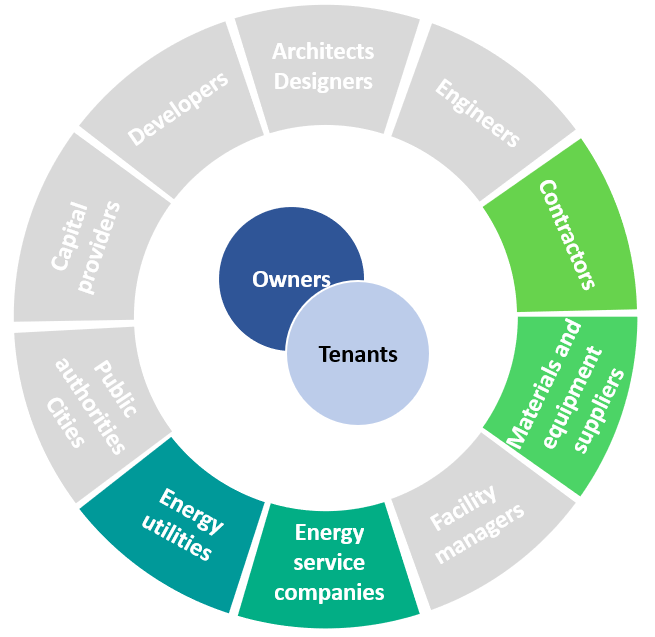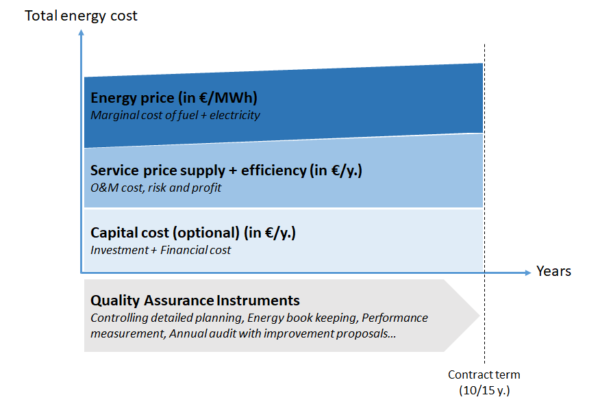Integrated Energy Contracting (IEC)
Description
The Integrated Energy Contracting (IEC) business model is a hybrid of Energy Supply Contracting (ESC) and Energy Performance Contracting (EPC) which combines two objectives:
- Reduction of energy demand through the implementation of energy efficiency measures in the areas of building technology (HVAC, lighting), building envelope and user behaviour;
- Efficient supply of the remaining useful energy demand, preferably from renewable energy sources.
It is methodologically based on the ESC model and is supplemented by a “deemed energy savings” approach regarding energy efficiency measures. Compared to standard ESC model, IEC model extends the range of services to the energy and emission savings potential for the whole building, with support of Quality Assurance Instruments (QAIs).
Deemed savings are a specific approach to estimate energy and demand savings, used with programs targeting simple efficiency measures with well–known and consistent performance characteristics. Basically, this method involves multiplying the number of installed measures by an estimated (or deemed) savings per measure, which is derived from historical evaluations. This approach replace the potentially complex and costly measurement of energy savings undertaken in the EPC business model. Therefore, IEC reduces transaction costs, especially for small projects.
As compared to standard ESC, the range of services in IEC model is extended to the overall building or commercial enterprise, so the offer is not limited to heat supply. Instead, the model is intended to be used for all energy carriers such as heat and electricity, but also other consumption media such as water or compressed air.
As with ESC and EPC, the IEC business model offers the building owner the choice to outsource technical and economic risks, associated with the implementation of Renewable Energy Technologies (RET) and energy efficiency measures, to a professional third party and buy services instead of individual components. IEC may be particularly suitable to combine supply from renewable sources with energy conservation measures, and thus accelerate RET adoption.
Basically, the IEC business model benefits from the ESC with similar price components, and it is supplemented with a flat rate price for the energy efficiency measures. Individual QAIs for the installed energy efficiency measures secure the functionality and performance of the measures, but not their exact quantitative outcome over the entire project cycle compared to EPC tools. The objective is to simplify the business model and to reduce (transaction) cost by balancing measurement and verification cost and accuracy. Appropriate QAI’s need to be defined for each energy efficiency measure, e.g. a one-time performance measurement for a new street lighting or a one-time thermographic analysis for verifying the quality of a refurbished building envelope. These QAIs replace the annual measurement and verification of the EPC savings guarantee.
"What” (value proposition)
The IEC business model provides customer with several advantages:
- Guarantees for the total cost savings and overall performance of the energy services;
- Affordable renewable heat and electricity;
- Reduced energy costs;
- Increased green, sustainable eco-friendly credentials;
- Reduced carbon footprint;
- Project facilitation;
- Market facilitation;
- Contracting
"Who” (target customer)

The IEC business model is partly based on the ESC model, which is applied in public, residential, commercial and industrial buildings, and the EPC model. As methodological problems of EPC related to baselines creation and adaption are avoided or at least reduced, commercial and public buildings (universities, campuses, hospital sites and larger schools, etc.) as well as the residential sector can be targeted.
More specifically, the customer targets are the public and private organizations in charge of the management and energy costs of their buildings.
"How” (value chain, activities, resources)
The ESCO is responsible for the implementation and operation of the energy efficiency package at its own expenses and risk, according to the project specific requirements defined by the client and the ESCO.
In some cases, a joint venture between the following players is practicable:
- An environmental consultant to provide information on the return on investment of the different renewable energy technologies;
- An energy company to implement run and maintain the technologies implemented (e.g. CHP and PV)
- A building construction company to implement the building renovations
Purchasing of final energy (electricity, fuels) mostly remains with the building owner. IEC combines energy efficiency and RET measures.

"Why” (revenue model and cost structure)
Cost structure for the main contractor:
The ESCO takes over the implementation and operation of the energy service package at its own expenses according to the specific requirements set by the client.
Revenue stream for the main contra ctor:
ctor:
The ESCO will be remunerated for the useful energy delivered, depending on the actual consumption as well as a flat rate service remuneration for Operation & Maintenance (O&M), managed with QAIs. The ESCO’s remuneration is made up of the following three (or four) price components:
- Energy price (dependent on actual consumption): to avoid incentives to sell more energy, the ESCO calculates the consumption related to cost only, i.e. exclusively the expenditure for fuel and auxiliary electricity. During the contractual period, the prices will be adjusted every year retrospectively by using statistical energy price indices depending on the fuel used (e.g. gas or biogas index), which are defined in the IEC contract;
- Service price energy supply and energy efficiency (flat rate): all operations cost of the energy efficiency measures, and other related cost for O&M, staff, insurance, management of the energy supply infrastructure as well as entrepreneurial risk. During the contractual period, the prices will be adjusted every year retrospectively by using statistical indices such as wage or investment good indices;
- Capital cost of energy efficiency and supply investments (Optional): if the project is (co-)financed, the ESCO receives an annuity remuneration for its capital cost minus subsidies and building cost allowances.





